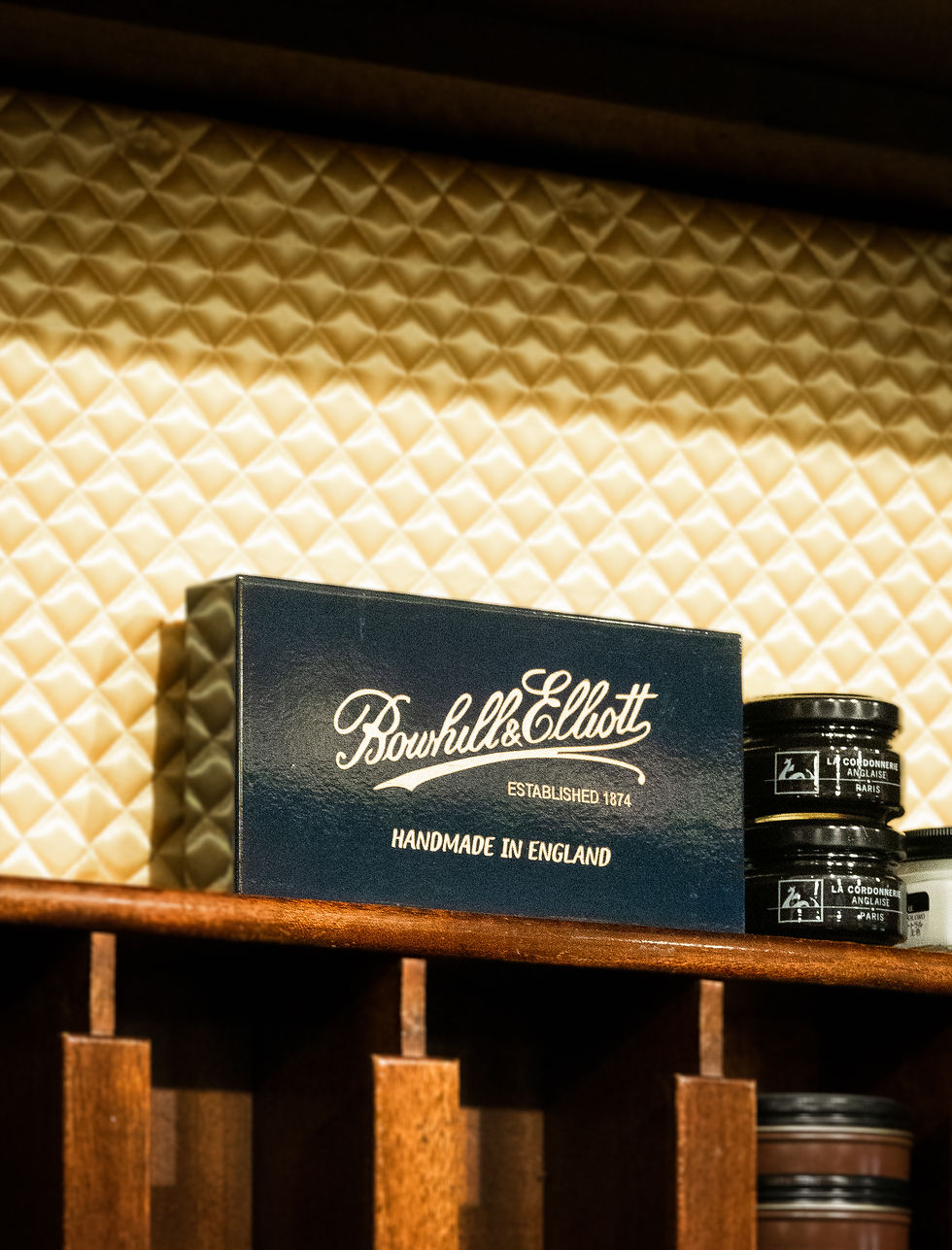Factory Visit: Bowhill & Elliott
- Linus Chu

- Oct 10, 2022
- 4 min read
Updated: Oct 17, 2022

Recently, I headed up to Norwich to visit Bowhill & Elliott in the good company of a few friends — Dennise Yeh and Ksenia Konovalova of The Sartorial Club, alongside Jack Collins from The Gentleman's Gazette.
It was a pleasant two hours train ride to reach the East Anglian town from London Liverpool Street station, making it fairly accessible for enthusiasts that are keen to witness the craftsmanship or simply learn about the business in person.
Some readers may know of Bowhill as a maker of velvet Albert slippers, as indicated in the title, manufacturing and wholesaling for more renowned household brands, such as Crockett & Jones.
While that remains the shoemaker's current main day-to-day operation, the store itself tells a different story; with every tiny detail within the shop hinting that Bowhill's shoemaking lineage goes much further back in time.

'Like a few shoe brands, Bowhill was also originally a bespoke shoemaking business when Odabiah Henry Bowhill, a local bespoke shoemaker, took an interest and purchased the current London street premise from an existing shoemaking business, Wright & Co, in 1874,' said Marc Debieux, now Head of Retail at Bowhill, who has over 20 years of experience working in the shoe industry. (Picture above)
'Then, with the large shoemaking factories opening up in Northampton in the following few years, people started buying more affordable ready-to-wear shoes, making bespoke shoemaking a very tough business to run.'
It was then that Bowhill diversified and started producing ready-to-wear shoes and boots intended for all users, as well as becoming a shoe emporium Norwich locals would know of today.
Curiously, it was also the first shoe shop to stock Crockett & Jones when the latter became more retail-focused in the 1940s, cementing the great working relationship between the two brands for the years to come.
I had the opportunity to examine the special Crockett & Jones recently released for Bowhill — a wholecut reimagined with grained leather and rubber soles for stormy weather, along with a uniquely round last; effectively defying all the conventional understanding of a wholecut's formality (See pictures below).
Needless to say, this twist on the traditionally formal shoe style is intentional. As Marc explained, 'it is essentially what you would wear for a pair of sneakers, but in leather.'



By now, you may be wondering where the slippers part fits into this story.
Curiously, that comes with Bowhill acquiring fellow Norwich shoemakers, the Osoeasie Slipper Company, in the 1960s. From then, the shoemaker has rechanneled all its focus into making house shoes and eventually integrated the factory arm of the business into its existing London street premise.
Fast forward to this day, you can find the door sign taken from Osoeasie's former office now being displayed on the door leading to Bowhill's basement workshop, where all the hand-welting is done. (Picture above)
A nice little touch of heritage, I'd say.

After a brief introduction of the brand history, Marc then brought us upstairs where all the in-house made slippers and pumps are being showcased.
It is a lovely space — as a matter of fact, one that Marc has only renovated with new furnishings he and his team acquired a couple of days before our visit. Prior to that, the now-slipper lounge served more as a men's section for the shoe emporium side of the business, while the ground floor space functioned as the women's section.
'It's what we think we should do to better the Bowhill & Elliott branding', Marc explained, 'if we were to attract customers to come and visit our retail shop locations, we must first start with our original premise.'



I always recommend customers visit a showroom in person if possible, not least because you can admire the hand-finishing detail or embroidery work up close. On top of that, you can get a better sense of what the artisans can achieve by physically interacting with the display pieces, as well as getting inspiration on what you can commission.
In this case, I took a particular liking towards the denim linen pumps as well as the tapestry Albert slippers showcased in the pictures above. It's always refreshing to see that slippers are being used outside of the traditional velvet and tweed, lounging at one's country estate context.
And it does align well with the notion that the line between loafers and slippers is becoming ever blurrier, seeing how popular it is to wear slippers on the street nowadays.
In fact, Bowhill also released a new and ever-growing collection of Street Slippers back in 2018 which features a leather lining (rather than a quilt), as well as a hardened leather or rubber sole for improved durability.



For the remainder of the trip, we were invited to tour the manufacturing space.
It is quite what you would expect from a small production, with the hand-clicking and sewing of the upper being done upstairs; and all the heavy-lifting work, such as hand-welting and turning monk slippers inside out, in the basement.
We were even offered the opportunity to try on some of these processes ourselves, albeit with less-than-ideal results. It's moments like these that make you more appreciative of the craftspersons' expertise and years of experience.


For anyone who is interested in commissioning a made-to-order pair, Bowhill now has a fairly easy-to-use interface for selecting the choice of upper and lining materials, as well as the font for the embroidery.
Having said that, for anyone who is planning to visit, you also get a nice little discount for shopping in person.
Photography: The Suitstainable Man team



Comments